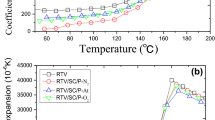Abstract
This paper describes a new method for rubber toughening brittle powder coatings. The design involves the use of toughening agents with specific physical and chemical properties. The modifiers are low-to-medium molecular weight polymers with polymerizable end groups (macromonomers). To achieve the physical properties required for fabrication into fine powders for subsequent deposition using conventional powder coating equipment, semi-crystalline polymers with Tg's well below room temperature and melting points above ≈70°C were required. Upon copolymerization with a thermosetting resin, crystallization of the modifier was precluded provided that low ethylene oxide compositions were employed. This scheme, in principle, yields an amorphous low Tg modifier chemically bound to the cured network. Poly(ethylene oxide), PEO, was found to be an excellent candidate, since it has a Tg of -68°C and a Tm of 70°C, sufficient crystallinity for friability and functional end groups for copolymerization. Free radical polymerization of 2,2-bis[4-vinylbenzoyloxyphenyl] hexafluoropropane and step-growth polymerization of 4,4′-(hexafluoroisopropylidene)diphenyl cyanate were utilized to demonstrate the feasibility of this approach. An electrostatic powder coater was used to co-deposit the PEO macromonomers with either of the thermosetting precursor monomers, followed by thermal curing to produce the modified networks. The resulting networks showed multiphase morphologies with improved toughness.
Similar content being viewed by others
References
Bocci GJ (1990) Met Finish 88(4): 19–22
Poole AJ (1991) Paintindia 41(6): 13–16
Lee H, Neville K (1967) Handbook of epoxy resins McGraw Hill New York
Bucknall C (1977) Toughened thermoplastics. Wiley
Kinloch AJ, Young RJ (1983) Fracture behavior of polymers. Applied Science Publishers New York
Riew CK, Gillham JK (1984) Rubber-modified thermoset resins. (Advances in Chemistry Series, No. 208)
Bauer RS (ed) Epoxy resin chemistry II. (ACS Symposium Series, No. 21)
Buner JR, Rushford JL, Rose WS, Hunston DL Riew CK (1982) J Adhesion 13
Gillham JK (1980) Soc. Pla. Eng., Proc. Ann. Tech. Conf. 38: 268
Hedrick JL, Hilborn JG, Prime RB, Labadie JW, Dawson DJ, Russell TP, Wakharker V (1993) Polymer: 000
Hedrick JL, Yilgor I, Jurek M, Hedrick JC, Wilks BL, McGrath JE (1985) Polymer Preprints 26: 293
Grigat E, Putter R (1967) Angew Chem Internat Edit 6: 206
Author information
Authors and Affiliations
Rights and permissions
About this article
Cite this article
Hedrick, J.L., Allen, R.D., Diaz, A. et al. A method for rubber toughening powder coatings. Polymer Bulletin 31, 715–721 (1993). https://doi.org/10.1007/BF00300132
Accepted:
Issue Date:
DOI: https://doi.org/10.1007/BF00300132




